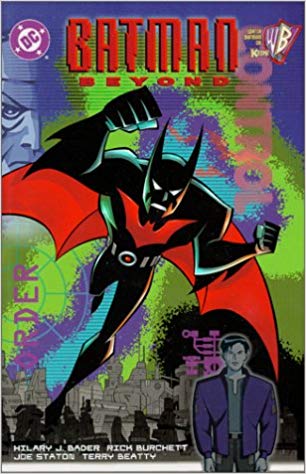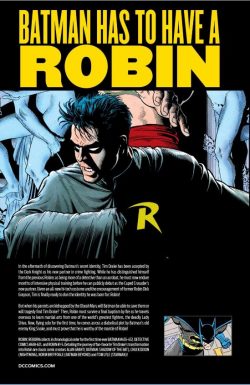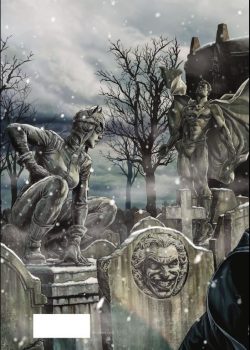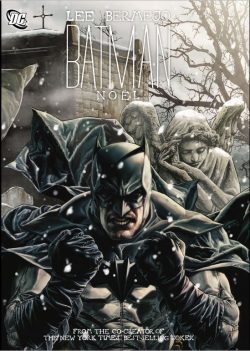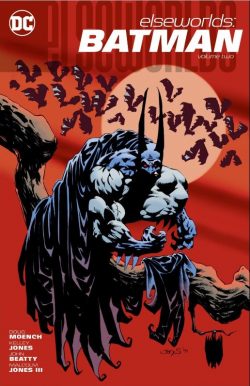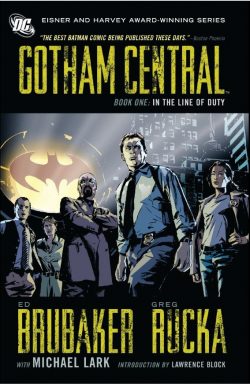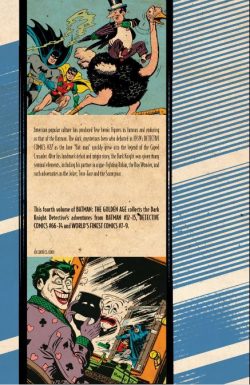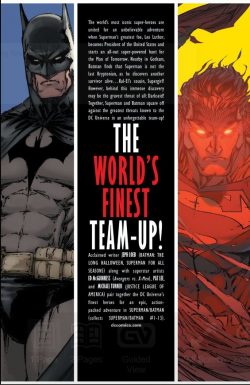
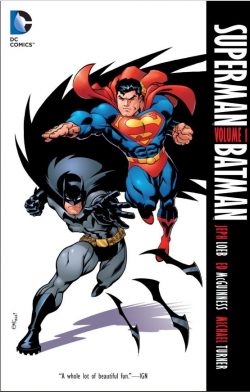
By Jeph Loeb, Ed McGuinness & Dexter Vines, Pat Lee & Dreamwave Productions, Michael Turner & Peter Steigerwald & various (DC Comics)ISBN: 978-1-4012-4818-5 (TPB)
Win’s Christmas Gift Recommendation: Compelling Comics Cavortings… 8/10
For many years Superman and Batman worked together as the “World’s Finest†team. They were best friends and the pairing made perfect financial sense as National/DC’s most popular heroes could cross-sell their combined readerships.
When the characters were redefined for the post-Crisis 1980s, they were remade as suspiciously respectful co-workers who did the same job but deplored each other’s methods and preferred to avoid contact whenever possible – except when they were in the Justice League (but for the sake of your sanity don’t fret that right now!).
After a few years of this new status quo the irresistible lure of Cape & Cowl Capers inexorably brought them together again with modern emotional intensity derived from their incontestably differing methods and characters.
In this rocket-paced, post-modern take on the relationship, they have reformed as firm friends for the style-over-content 21st century, and this is the story of their first outing together. Outlawed and hunted by their fellow heroes, Superman finds himself accused of directing a continent-sized chunk of Kryptonite to crash into Earth, with Batman accused of aiding and abetting…
To save Superman, the world and their own reputations they are forced to attempt the overthrow of the United States President himself. Of course, said President is the unspeakably evil Lex Luthor. Back in 2003 he was considered the least likely leader America could ever elect…
I deeply disliked this tale when I first read it: Plot is reduced to an absolute minimum in favour of showy set-pieces, previously established characterisation often hostage to whatever seems the easiest way to short-cut to action (mortal foes Captain Atom and Major Force work together to capture our heroes because President Luthor tells them to?) but after all these years it’s worthy of another look and I’m not ashamed to say that I’ve changed my opinion somewhat…
This paperback (and eBook) compilation collects issues #1-13 of the hip turn of the century reboot Superman/Batman (and includes a vignette from Superman/Batman Secret Files 2003) collectively spanning October 2003 to October 2004)
The action – written by Jeph Loeb and illustrated by Ed McGuiness & Dexter Vines – opens with ‘World’s Finest’ as the Dark and Light Knights follow telling leads in separate cases back to shape-shifting cyborg John (Metallo) Corben, discovering evidence to suggest that the ruthless cyborg might have been the at-large-for-decades shooter in the still unsolved double murder of Thomas and Martha Wayne…
Even that bombshell seems inconsequential after the mechanoid monster shoots Superman in the chest with a kryptonite bullet before burying the stunned duo under tons of Earth in a Gotham graveyard…
Meanwhile at the Pentagon, President Lex is informed that a toxically radioactive lump of Krypton the size of Australia is on a collision course with Earth. Implausibly adopting (and foreshadowing) the “Fake News†disinformational line that Superman has summoned it, the Federal Government issues an arrest warrant for the Man of Steel and convenes a metahuman taskforce to bring him in…
Escaping certain doom thanks to Batman’s skill and unflappable nerve, the blithely unaware heroes reach medical help in the Batcave in ‘Early Warning’, only to be attacked by an older version of Superman, determined to prevent them making a mistake that will end life on Earth…
After a massive nuclear strike (somehow augmented by embargoed Boom Tube technology from hell-world Apokolips), Luthor overrules Captain Atom’s qualms about the mission and orders his anti-Superman squad to apprehend their target wherever he might be hiding.
The President then goes on television to blame the alien for the impending meteor strike and announces a billion-dollar Federal bounty on the Action Ace…
Man of Tomorrow and Man of Darknight Detective respond by direct assault in ‘Running Wild’, hurtling towards Washington DC only to be ambushed en route by a greed-crazed army of super-villains and mind-controlled heroes before Atom’s group – Green Lantern John Stewart, Black Lightning, Katana, Starfire, Power Girl and certified quantum psychopath Major Force – join the attack…
As the combatants ‘Battle On’, in the Oval Office even fanatical civil servant Amanda Waller – commander of covert Penal Battalion the Suicide Squad – begins to realise something is wrong with the President.
For a start, his behaviour is increasingly erratic, but the real clue is that he is juicing himself with a kryptonite-modified version of super-steroid venom…
The blistering battle between the outlawed heroes and Atom’s unit extends as far as Japan, (where the Cape & Cowl Crusaders are secretly organising a last-ditch solution to the imminent Kryptonite continent crash) before Major Force begins to smell a rat and realises some of his team are actually working with Superman and Batman.
Military martinet Captain Atom is not one of them, but eventually even he is made to see reason – only moments before the deranged Major goes ballistic and nearly turns Tokyo to ashes…
Using his energy-absorbing powers, Atom prevents the holocaust, but the monumental radiation release triggers his “temporal safety-valve†and the silver-skinned soldier materialises in a future where Earth is a barren cinder and only an aged, tragic, broken Superman resides…
Meanwhile in the present, the Presidential Pandemonium has prompted the venerable Justice Society of America to step in; despatching Captain Marvel and Hawkman to apprehend the fugitive Superman and Batman.
Apparently successful, the operation triggers a back-up team (Supergirl, Nightwing, Steel, Superboy, Natasha Irons, Robin, Huntress, Batgirl and even Krypto) who invade the White House only to be defeated by Luthor himself, high on K-Venom and utilising Apokolyptian technology in ‘State of Siege’…
With extinction only moments away and a deranged President Luthor on the loose, Superman and Batman prepare to employ their eleventh-hour suicidal salvation machine but are caught off-guard when a most unexpected substitute ambushes them to pilot the crucial mission in ‘Final Countdown’…
In so many ways this yarn is everything I hate about modern comics. The story length is artificially extended to accommodate lots of guest stars and superfluous fighting, whilst large amounts of narrative occur off-camera or between issues, presumably to facilitate a faster, smoother read.
On the plus side, however, is the fact that I’m an old fart. There is clearly a market for such snazzy, souped-up, stripped down, practically deconstructed comic fare. And if I’m being completely honest, there is a certain fizz and frisson to non-stop, superficial all-out action – especially when it’s so dynamically illustrated.
Public Enemies looks very good indeed and, if much of the scenario is obvious and predictable, it is big and immediate and glossy like a summer blockbuster movie is supposed to be.
The epic is followed by a stand-alone tale starring Robin – the Tim Drake version – and semi-Kryptonian clone Conner Kent.
‘Protégé’ sees the assistants – don’t call them sidekicks – despatched to Japan to end the threat of a new Toyman. This particular giggling genius is a lethally brilliant kid and their off-the-wall solution to his antics is both smart and effective…
Next follows a tale and situation that only comics could conceive.
For decades DC really couldn’t make up their minds over Supergirl. I’ve actually lost count of the number of different versions that have cropped up over the years, and I’ve never been able to shake the queasy feeling that above all else she’s a concept that was cynically shifted from being a way to get girls reading comics to one calculated to ease young male readers over that bumpy patch between sporadic chin-hair outbreaks, voice-breaking and that nervous period of hiding things under your mattress where your mum never, never ever looks…
After a few intriguing test-runs the first true Girl of Steel debuted as a future star of the ever-expanding Superman pocket universe in Action Comics #252 (May 1959). Superman’s cousin Kara Zor-El had been born on a city-sized fragment of Krypton, hurled intact into space when the planet exploded. Eventually Argo City turned to Kryptonite like the rest of the detonated world’s debris and her dying parents, observing Earth through their vision-scopes, sent their daughter to safety as they apparently perished.
Landing on Earth, she fortuitously met Superman who created the identity of Linda Lee and hid her in an orphanage whilst she learned of her new world and powers in secrecy and safety.
Her popularity waxed and waned over the years until she was earmarked for destruction as one of the attention-grabbing deaths during Crisis on Infinite Earths.
However, after John Byrne successfully rebooted the Man of Steel, non-Kryptonian iterations began to appear – each with her own fans – until early in the 21st century the company Powers-that-Be decided the real Girl of Steel should come back… sort of…
Thus, this visually intoxicating version (from Superman/Batman #8-13) resets to the original concept and has a naked blonde chick arrive on a colossal Kryptonite meteor, claiming to be Superman’s cousin…
Written by Loeb with captivating art by Michael Turner & Peter Steigerwald, the action commences in ‘Alone’, as a quarantined Superman chafes at enforced detention, the Dark Knight explores a section of the meteor submerged in Gotham Bay.
The JLA have all been active, clearing away the deadly fragments, but this last one is most disturbing. As Batman quickly grasps, it’s a ship, but its single passenger is now missing…
Soon the Gotham Guardian is tracking a wave of destruction caused by a seemingly confused teenaged girl with incredible powers and only Superman’s unwise early intervention stops the mounting carnage.
Their subsequent investigations reveal the comely captive to have all the Man of Tomorrow’s abilities and she claims – in fluent Kryptonian – to be the daughter of his long-dead uncle Zor-El…
The mystery further unfolds in ‘Visitor’ as a deeply suspicious Batman and ecstatic Superman continue their researches, arguing their corners as the most powerful girl on Earth becomes increasingly impatient. Fuelling the Dark Knight’s concern is superdog Krypto’s clear and savage hostility to the newcomer and Kara’s convenient claim that she has amnesia…
Then as Clark Kent endeavours to acclimatise his cousin to life on Earth, on the hellish world of Apokolips vile Granny Goodness and her Female Furies are ordered by ultimate evil space-god Darkseid to acquire the pliable naive newcomer…
Before they can strike, however, an attack comes from an unexpected source, as former ally Harbinger, ruthless hunter Artemis and beloved ally Wonder Woman ambush the Kryptonians. …
Princess Diana has acted arbitrarily but from absolute necessity: kidnapping Kara and bringing her to the island home of the Amazons to be trained in the use of her powers as a ‘Warrior’.
Superman’s growing obsession has rendered him unable to see her potential for destruction, despite a cryptic message on her space ship from Zor-El, and Wonder Woman chose to strike first and ask later…
With tempers barely cooled, Dark Knight and Action Ace are invited to observe Kara’s progress weeks later, just as the tropical paradise is assaulted by an army of artificial Doomsdays manufactured on Apokolips…
The wave of slaughter is a feint, but by the time the rampaging horrors are all destroyed, the Furies have done their work, slaughtering Kara’s only friend and stealing away the Kryptonian kid…
In ‘Prisoner’, DC’s superheroic high trinity enlist the aid of Apokolyptian émigré Big Barda and stage a devastating rescue mission to Darkseid’s homeworld, but not before the Lord of Evil apparently twists the innocent Girl of Steel into his tool: making her a ‘Traitor’ to the living…
The Master of Apokolips has never faced a foe as adamant as Batman and the quartet are unexpectedly victorious, but after returning Kara to Earth and announcing her as the new Supergirl, the heroes discover that they are not safe or secure, and in ‘Hero’ Darkseid horrifyingly returns to exact his ultimate revenge…
For me, the most intriguing aspect of this sometimes overly-sentimental tale is Batman’s utter distrust and suspicion of Kara as she is hidden from the world while she assimilates, but there’s plenty of beautifully rendered action – plus oodles of lovingly rendered girl-flesh and titillating fetish outfits jostling for attention amidst the lavish fight-scenes and interminable guest-cameos, should that be to your tastes – and enough sheer spectacle to satisfy any Fights ‘n’ Tights fans.
Even now the goods things have not been exhausted as Superman/Batman Secret Files 2003 provides a charming peek into the past with ‘When Clark met Bruce’ (“A tale from the days of Smallvilleâ€) in which bucolic 2-page snippet, Loeb & Tim Sale effectively tease us with the question of what might have been, had the go happy-go-lucky Kent boy actually got to have a play-date with that morose, recently orphaned rich kid from Gotham City…
Filling out the experience are pictorial fact-file on Superman, Batman,
President Lex Luthor, Talia and Metallo, plus a full cover gallery by McGuiness & Vines, Turner & Steigerwald and Jim Lee & Scott Williams and studies and design sketches for Supergirl.
Full of flash and dazzle this mighty tome might well be the kind of Fights ‘n’ Tights thrill you’re looking for this yule season.
© 2003, 2004, 2014 DC Comics. All Rights Reserved.


